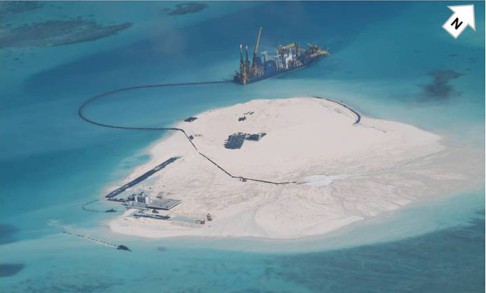From InterAksyon (Sep 17):
China's island airstrips to heighten South China Sea underwater rivalry
 Subi Reef is shown in this handout satellite image dated September 3, 2015 and provided by CSIS Asia Maritime Transparency Initiative/Digital Globe September 14, 2015. REUTERS/Handout via Reuters
China's apparent construction of a third airstrip on its
man-made islands in the disputed South China Sea could fill a gap in Beijing's
anti-submarine defenses, complicating operations for the US Navy and its
allies, Chinese and Western experts said.
Subi Reef is shown in this handout satellite image dated September 3, 2015 and provided by CSIS Asia Maritime Transparency Initiative/Digital Globe September 14, 2015. REUTERS/Handout via Reuters
China's apparent construction of a third airstrip on its
man-made islands in the disputed South China Sea could fill a gap in Beijing's
anti-submarine defenses, complicating operations for the US Navy and its
allies, Chinese and Western experts said.
While most attention has been on the power projection China would get from its new islands in the
Spratly archipelago, China
could also use them to hunt rival submarines in and beyond the strategic
waterway, they said.
Possessing three airstrips more than 1,400 km (870 miles)
from the Chinese mainland would enable Beijing
to extend the reach of Y-9 surveillance planes and Ka-28 helicopters that are
being re-equipped to track submarines, the experts added.
A Pentagon report in May noted China lacked a robust anti-submarine
warfare capability off its coastline and in deep water.
Strengthened anti-submarine capabilities could also help China protect the movements of its Jin-class
submarines, capable of carrying nuclear-armed ballistic missiles and which are
at the core of China's
nuclear deterrence strategy, said Zhang Baohui, a mainland security specialist
at Hong Kong's Lingnan
University.
"That would provide greater security for China's nuclear
submarines to survive ... and if necessary to execute their orders in wartime,"
Zhang told Reuters.
"They would be safer than in open oceans where China cannot
provide adequate support."
The artificial islands, built on seven reefs over the last
two years, will be high on the agenda when Chinese President Xi Jinping has
talks with President Barack Obama in Washington
next week.
Washington
has criticized the reclamation and construction.
China,
increasingly confident about its military firepower, has repeatedly stressed it
has "indisputable sovereignty" over the entire Spratlys, saying the
islands would be used for civilian and undefined military purposes.
Foreign Minister Wang Yi on Wednesday said
"necessary" construction work would improve conditions on the
islands.
Triangle of airstrips
Satellite photographs show construction is almost finished
on a 3,000-meter-long (10,000-foot) airstrip on Fiery Cross Reef..
Recent images showed Subi Reef would also have a 3,000-meter
airstrip, Greg Poling, director of the Asia Maritime Transparency Initiative at
the Center for Strategic and International Studies think tank in Washington, said on
Monday.
Poling, citing images taken last week, said China also
appeared to be doing preparatory work for an airstrip on Mischief Reef.
Together, the three islands form a rough triangle in the
heart of the Spratlys, where the Philippines,
Vietnam, Malaysia, Brunei
and Taiwan
all have competing claims.
While a noisy and relatively shallow operating environment
for submarines, the South China Sea has
several deep water channels giving access to the Indian and Pacific oceans.
Asked if Washington was
concerned the airstrips would enhance China's
anti-submarine capabilities, a Pentagon spokesman, Commander Bill Urban, said
the United States was monitoring
events in the South China Sea.
In a speech on Wednesday, US Defense Secretary Ash Carter
said the United States
would "fly, sail, and operate wherever international law allows".
"Turning an underwater rock into an airfield simply
does not afford the rights of sovereignty or permit restrictions on
international air or maritime transit," Carter told a US Air Force
conference.
One mainland-based naval analyst said China was
trying to improve sonar and other detection equipment carried aboard its Y-9
patrol planes and Ka-28 helicopters.
China
was also expected to put detection devices on the seabed around the new
islands, creating "an electronic gateway", he added.
Nuclear deterrence
Zhang has previously said ballistic missile submarines are
more important for China's
nuclear deterrent than other powers given Beijing's
policy, dating back to the 1960s, of only using nuclear weapons if attacked
with them first.
This means China's
land-based weapons would be vulnerable to a first strike if Beijing stuck to its "no first use"
policy in a conflict.
Chinese media and international military blogs this year
have shown photographs of Jin-class submarines operating from a naval base on Hainan Island
off southern China.
It's unclear if they have been armed with long-range JL-2
nuclear ballistic missiles.
The Pentagon report said four Jin-class submarines were
operational, with a fifth expected to be added.
"China
will likely conduct its first (submarine) nuclear deterrence patrol sometime in
2015," the report said.
The importance of that deterrence means China is likely to eventually impose an Air
Defence Identification Zone (ADIZ) over part of the South China Sea, security
experts say, mirroring its declaration of such a zone over the East China Sea in late 2013.
In a return to Cold War-style cat-and-mouse operations
undersea, rival submarines were already trying to track each other, said
Western and Asian naval officers with experience of anti-submarine warfare.
They said the United States
would be trying to identify and track individual Chinese submarines, just as it
stalked then-Soviet Union missile submarines across the Pacific and Atlantic oceans during the Cold War.
Japan's
ultra-quiet diesel-electric submarines were also increasingly active while,
over time, Vietnam's
emerging fleet of advanced Russian-built Kilo-class submarines would be another
headache for China.
"We're looking at them, and now increasingly they are
looking at us," one retired Asian-based naval officer said of China's growing
undersea operations.
http://www.interaksyon.com/article/117693/chinas-island-airstrips-to-heighten-south-china-sea-underwater-rivalry




